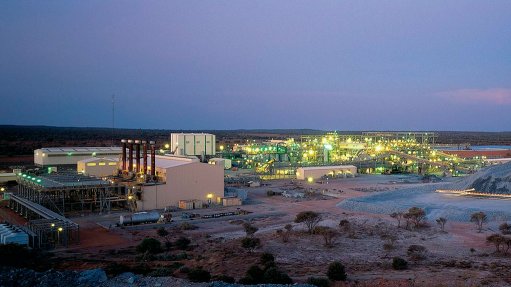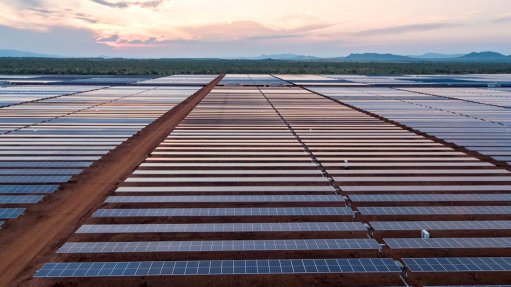Mwana swings to FY profit in ‘turning point’ year
JOHANNESBURG (miningweekly.com) – After posting a $43.5-million loss in 2013 as a result of a $43.7-million impairment charge on Zimbabwe subsidiary Bindura Nickel Corporation (BNC), multicommodity miner Mwana Africa has swung to a net profit of $50.6-million for the 2014 financial year.
Attributable group net profit for the year of $36.6-million equated to basic earnings a share of $2.89, from a loss a share of $2.62 in the prior period.
Describing 2014 as a “turning point” for the Africa-focused mineral developer, CEO Kalaa Mpinga said during a webcast on Wednesday that, despite some temporary setbacks at the beginning of the year, Mwana had made substantial progress in the past financial year and had strengthened the company’s financial structure.
“Our principal success came with the resumption of sales of nickel-in-concentrates by BNC’s Trojan nickel mine in terms of an offtake agreement with Glencore. The significant cash-flow improvement that stemmed from higher nickel prices was complemented by solid production outcomes following the shift to mining the orebody’s higher-grade [zones, known as] massives,” he commented.
Elaborating on the group’s financial showing, Mpinga noted that group earnings before interest, taxes, depreciation and amortisation (Ebitda) had increased 40.4% to $25-million, while a focused cost-savings drive had cut corporate cash costs from 7.8% to 4.2% of revenue.
Group net cash from operating activities was up 60.5% over the period to $6.1-million.
FLAGSHIP PERFORMANCE
Looking more closely at the group’s operational performance, output from Mwana’s flagship Freda Rebecca gold mine, in Zimbabwe, contracted 7.3%
to 58 704 oz for the year, with a “significant contributor to the variance” being a leach tank failure in the last quarter of 2013.
Average quarterly production for the financial period was 14 676 oz.
Recoveries had now been restored following the replacement of the failed leach tank and the commissioning of a new, additional leach tank.
The lower output came despite the operation milling a record 1.06-million tons during the 12 months but was exacerbated by lower head grades and mechanical problems with the mills during the latter part of the financial year.
The operation’s mill head grade of 2.1 g/t was 20% down on the previous year’s 2.64 g/t. This head grade decline was, in part, compensated by an improvement in mill recovery to 82.35% from 81%.
Mpinga added that an important emphasis at Freda Rebecca over the year had been on containing costs.
While the average all-in sustaining cash cost of $1 186/oz remained “comfortably” below the average gold price for the entire year, by the fourth quarter, all-in sustaining cash costs were close to the gold price, owing to the operation not achieving its volume targets.
Operating costs during the period totalled $61.3-million for the period under review.
“I am, however, confident that by increasing gold production and with careful cost controls the mine will continue to operate profitably. Our policy is to mine profitable ore – we are not in the business of producing at any cost,” Mpinga assured.
Meanwhile, Mwana said the mine, which had been in production since 1988, had accumulated some 13-million tons of gold-bearing tailings in three main storage facilities within the mine lease area.
During the 2013 financial period, the economic potential of recovering gold from Freda Rebecca’s tailings dumps was evaluated and the construction of a pilot recovery plant initiated. The plant was completed and commissioning began in the year under review.
“The objective of the pilot-scale test plant is to prove that gold can be recovered economically from the tailings with little reprocessing and low mining and handling costs. An augering programme over the dumps is expected to result in a Joint Ore Reserves Committee-compliant mineral resource that has the potential to add significantly to Freda Rebecca’s gold production,” the group noted.
During the year, Freda Rebecca sold 58 704 oz of gold at an average price of $1 319/oz, generating revenue of $77.5-million.
Profit before tax for the year was $8.6-million.
TROJAN NICKEL
While Freda Rebecca was being brought up to steady state, profitable operations, production at BNC’s newly reopened Trojan nickel mine was being ramped up to full capacity.
BNC’s mines, smelter and refinery were placed on care and maintenance in 2008 and remained so until the conclusion of BNC’s rights issue and restructuring in September 2012, when mining restarted at the Trojan mine.
The restart involved the refurbishment of the handling facilities for the surface milling flotation, tailings and concentrate, while the hot and cold commissioning of the plant concluded shortly thereafter.
Progress on surface was matched by a successful ramp-up of underground operations and, in April 2013, BNC sold its first shipment of nickel concentrate since the restart to Glencore, BNC’s offtake partner.
However, Mpinga explained that, as a result of depressed nickel prices, additional financing to fund full ramp-up was not secured and, during the first quarter of the 2014 financial year, the Trojan mine plan was revised to target the massives, with the aim of reducing the cost of nickel produced.
“The impact of this was already being seen in the first six months, with a drop in cash costs from $19 251/t in the first quarter to $9 689/t in the second quarter. In October 2013, a competent person’s review of BNC’s business plan for Trojan’s operations concluded that the plan was realistic and achievable.
“This enabled BNC to update its ore reserves statement to total proven and probable reserves of 3.168-million tons at an average grade of 1.04% for 32 975 t of contained nickel. This denotes a 28% increase on the previously reported Trojan reserves of 25 810 t of contained nickel,” he noted.
Work had since started on the Trojan shaft redeepening project, which had been suspended while the mine was on care and maintenance.
The redeepening would extend the operating horizon of Trojan from 35 level to 45 level and secure the life-of-mine of the Trojan asset.
The operation continued making progress towards steady-state processing of 195 000 t a quarter.
BNC generated $65-million in revenue over the period through the sale of nickel-in-concentrate, while operating costs increased from $15.9-million to $45.7-million owing to the restart of the mine.
BNC reported Ebitda of $19.4-million for the year.
MULTICOMMODITY PLAYS
Looking to the group’s other assets, Mwana continued to explore its 33 Katanga copper exploration concessions, in the Democratic Republic of Congo, over the period, having established a joint venture (JV) agreement with copper miner Zhejiang Hailiang to explore some of these licensed areas.
Exploration on the various targets entered Phase 2 during the year and saw the completion of a generation exercise, which defined high-priority targets for follow-up exploration in the coming year.
Meanwhile, Mwana’s South Africa-based Klipspringer JV diamond operation remained on care and maintenance after shaft flooding in 2010 and 2011.
Ultimate funding from Mwana had continued to maintain the asset in a ready state, while its interest in the JV had increased to almost 70% owing to “noninvestment” by its black economic-empowerment partner in the working capital requirements of Klipspringer.
“Care and maintenance will continue until a source of finance is secured to restart the mine and has ensured that the mine will be in a position to take advantage of favourable market conditions,” Mpinga explained.
PROSPECTS
Looking ahead, Mwana chairperson Stuart Morris said he had made “no forecast” of the group’s near-term performance, particularly given the current uncertainties over commodity prices, adding that there remained “some distance to travel” before the company generated positive cash flows at all projects.
“But, while we will be patient in achieving this, we remain mindful of our commitment to deliver wealth to our shareholders. We shall build on our assets that are generating positive cash flows and carefully develop those that are still in their infancy, or are being maintained in anticipation of profitable development,” he noted.
Mwana did not declare a dividend for the period.
Comments
Press Office
Announcements
What's On
Subscribe to improve your user experience...
Option 1 (equivalent of R125 a month):
Receive a weekly copy of Creamer Media's Engineering News & Mining Weekly magazine
(print copy for those in South Africa and e-magazine for those outside of South Africa)
Receive daily email newsletters
Access to full search results
Access archive of magazine back copies
Access to Projects in Progress
Access to ONE Research Report of your choice in PDF format
Option 2 (equivalent of R375 a month):
All benefits from Option 1
PLUS
Access to Creamer Media's Research Channel Africa for ALL Research Reports, in PDF format, on various industrial and mining sectors
including Electricity; Water; Energy Transition; Hydrogen; Roads, Rail and Ports; Coal; Gold; Platinum; Battery Metals; etc.
Already a subscriber?
Forgotten your password?
Receive weekly copy of Creamer Media's Engineering News & Mining Weekly magazine (print copy for those in South Africa and e-magazine for those outside of South Africa)
➕
Recieve daily email newsletters
➕
Access to full search results
➕
Access archive of magazine back copies
➕
Access to Projects in Progress
➕
Access to ONE Research Report of your choice in PDF format
RESEARCH CHANNEL AFRICA
R4500 (equivalent of R375 a month)
SUBSCRIBEAll benefits from Option 1
➕
Access to Creamer Media's Research Channel Africa for ALL Research Reports on various industrial and mining sectors, in PDF format, including on:
Electricity
➕
Water
➕
Energy Transition
➕
Hydrogen
➕
Roads, Rail and Ports
➕
Coal
➕
Gold
➕
Platinum
➕
Battery Metals
➕
etc.
Receive all benefits from Option 1 or Option 2 delivered to numerous people at your company
➕
Multiple User names and Passwords for simultaneous log-ins
➕
Intranet integration access to all in your organisation





















